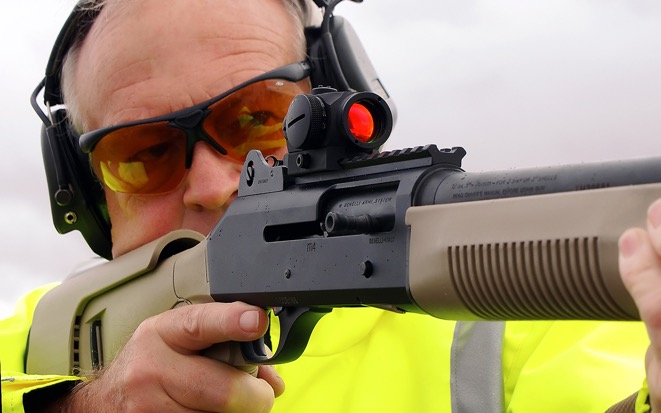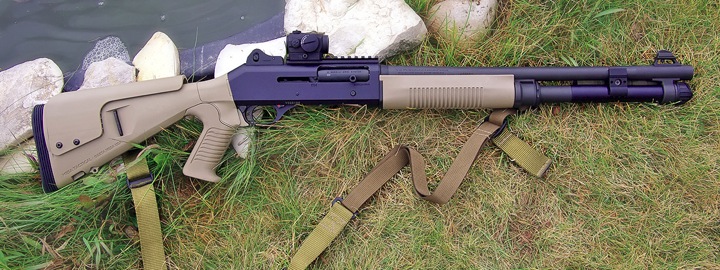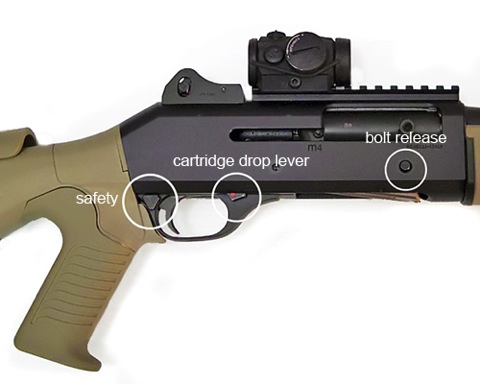Cover story from Blue Line Law Enforcement Magazine, December 2012

The Benelli M4 Tactical
Benelli writes the book on modern duty shotguns
by Dave Brown
Every battle is won before it is ever fought.
This is as true today as when Sun Tzu first wrote it 2000 years ago.
When the Chinese General first penned “The Art of War,” he never envisioned modern police weapons but were he alive today, he would fully agree with the strategy that superior training, tactics and firepower mean that the best battles are the ones that never need to be fought.
Perhaps a more modern variation could be described by another adage – the first rule of a gunfight is to bring a gun; the second rule is to bring lots of friends with guns.
And, if your friends have the Benelli M4, that would also help.
Originally designed for combat, the M4 shotgun is a simple, reliable design with unique features which make it ideal as a patrol weapon. It is also one of the few shotguns that we have ever tested which worked perfectly right out of the box. This is why we consider it to be the world's best tactical shotgun.
World’s Best Police Shotgun
The modern police shotgun is a simple and effective weapon, capable of stopping most close-range gunfights quickly and decisively. They require minimal fine motor skills that don't exist in life-threatening situations, and can be loaded with a wide range of ammunition choices. A tube full of 12-gauge slugs has the energy equivalent of an entire 30-round magazine of .223 rifle rounds.
Current police shotguns haven't evolved much since the First World War when the tube-fed, pump-action shotgun first saw wide service. In fact, the most common police shotgun around the world today is still that same tube-fed pump-action design. It is simple, reliable, compact and can fire rounds that carry a great deal of impact at short range.
Semi-automatic police shotguns such as the Remington 11-87 Police and the Benelli M4 are less common than pumps in patrol cars, but three significant events in the last five years may change that.
First, people are recognizing that a modern police semi-automatic shotgun is just as simple and reliable as a pump action with the right ammunition.
Second, with a wider introduction of semi-auto rifles, there is a better understanding that semi-auto shotguns are easier to train on, kick far less than their pump-action brethren and fit the patrol officer and their modern body armour much easier.
Third, there has been resurgence in shotgun training incorporating modern techniques and tactics. Trainers are finally taking police shotgun training just as seriously as patrol rifle training. Good tactical and patrol shotgun courses that emphasize speed, accuracy, safety and responsibility are now clearly demonstrating the superiority of semi-automatics.
Most of today's patrol cars still sport a pump-action shotgun in an overhead rack simply for cost reasons, but anyone who feels the modern semi-auto is more complicated or less reliable than a pump has never spent much time shooting them.
Plus, if we truly believe that the modern police officer can't be trained to manipulate one more button under stress on their shotgun, then we need to remove patrol rifles, two-way radios, lighting control panels, automatic transmissions and laptop computers from all patrol cars.
Meet the Benelli M4
The M4 semi-auto uses an inertia-operated bolt to eject and load rounds from an underbarrel magazine tube. It also has a unique gas-operated mechanism to assist the inertia operation of the bolt, giving it some significant advantages over straight inertia-operated semi-automatics. Benelli refers to the operating system as Auto Regulating Gas Operated (ARGO). It uses two gas ports located just slightly ahead of the chamber to bleed a small amount of combustion gases from the barrel. They impinge on two stainless-steel pistons and operating rods to assist in opening the bolt. The advantage is that the M4 has the typically reduced recoil of gas-operated shotguns but maintains the speed of an inertia-operated design.
In shotgun comparison tests in 2011, we found the M4 shot-to-shot times to be approximately .18 to .20 seconds, in comparison to the Remington gas-operated 11-87 Police at .24 to .26 seconds. This means it will cycle as fast as a trigger finger is physically able to move; as long as the shooter can keep their sights on target, they could conceivably place five slugs into a threat in just under one second.
The current version of the M4 contains five rounds in a tubular magazine, although law enforcement versions may be ordered with a seven round tube. Barrel locking is achieved by a rotating bolt with two lugs. Benelli used the basic inertia bolt operation from its M1 and M2 shotguns and added the dual-piston ARGO gas assist. The result is a shotgun that is reliable with a wide variety of ammunition and is very fast to cycle.
Military ghost-ring sights also mean that it is both fast and accurate at any short- to intermediate-range encounter distance. A receiver-mounted Picatinny rail comes standard to accommodate variations in electronic sights and night-vision requirements as needed.
Semi-auto police shotguns once had a reputation for failing to cycle certain loads but our testing found the M4 to be 100 per cent reliable with standard police buckshot and slug rounds. It also cycled heavy target loads of birdshot rounds for training. Provided the shooter sticks to 3-dram-equivalent rounds of about 1,200 feet per second or more muzzle velocity, they should have no problems. Like any other police weapon, it should be extensively test-fired with the appropriate duty load before installation in a patrol car.
Many users suggest breaking in a brand new M4 with heavy loads for a few hundred rounds but in our testing, the Benelli was the first semi-auto shotgun we've ever fired that has been 100 per cent reliable right out of the box and NEVER experienced a failure of any kind. While admittedly much more expensive than most pump-action police shotguns, it still costs about the same as any good patrol rifle.
It will fire 2 ¾ inch and 3 inch shells of varying power levels with no need for operator adjustment and the simple design of the gas ports, dual self-cleaning pistons and dual operating rods mean a minimum of moving parts, allowing it to function with minimal cleaning. There is very little residue buildup from combustion gases and an occasional shot of a quality spray lube on the bolt is about all that is needed to keep it functioning for thousands of rounds. It will also fire less-than-lethal rubber slugs, bean-bag rounds and sock rounds by cycling the action manually.
History of the M4
The U.S. Army Armaments Research, Development and Engineering Center (ARDEC) at Picatinny Arsenal, NJ requested submissions in 1998 for a new 12 gauge, semi-automatic joint combat shotgun. Benelli Armi SpA of Urbino, Italy responded by designing and building the M4 Super 90 Combat Shotgun and delivered five samples to the Aberdeen Proving Ground in Maryland. After intense testing, ARDEC awarded the M1014 Joint Service Combat Shotgun contract to Heckler & Koch, USA for importation of the M4. Now officially designated the M1014, the first of what would become a 20,000-unit contract were delivered to the United States Marine Corps in 1999.
The M1014 was developed on the Benelli M1 and M2 design. Both use a very lightweight, inertia-operated bolt mechanism to eject a fired shell and feed in a new one very quickly. They are the fastest-operating shotgun mechanisms in the world but one of the downsides is that they tend to kick like a mule. An inertia-operated bolt relies on the shotgun being shoved back into the shoulder to delay the unlocking, giving time for the shot charge to leave the barrel before opening. They are also quite sensitive to weight and extra accessories, which can reduce the reliability of the operation.
With their new M4, Benelli created an all-new operating system with the ARGO design. This effectively increased the reliability, especially in adverse conditions, and significantly reduced the recoil. It also allowed alternate sights and accessories to be added without compromising reliability.
After proving itself in combat, Benelli slightly redesigned the M1014 and released it to the civilian and law enforcement markets in North America as the M4 Super 90. It added removable choke tubes to the barrel and replaced the military two-position collapsible stock with a three-position adjustable stock to better accommodate police officers wearing body armour.
The aftermarket quickly caught up with the M4's incredible popularity and there are many sights, stocks and accessories now available. Mesa Tactical even designed a shorter length-of-pull stock, named after the Urbino home of Benelli, and sells it in black, olive and desert tan (picture above).
Operation of the M4
It is obvious from the moment one picks up a M4 that it is different from most other police shotguns. It uses a free carrier design, which means a round is not fed from the magazine tube onto the shell carrier unless the trigger is pulled or the cartridge drop lever is depressed. No rounds are fed from the magazine until the operator wants them. An officer can take a loaded M4 and cycle the bolt as many times as they wish without shells feeding from the tube.
This is a very intelligent design and perfectly suited for use in a police car. Moving from the cruiser-carry condition (empty chamber; loaded magazine tube; safety on) simply requires exiting the vehicle, depressing the cartridge drop lever (see photo) and cycling the action with authority.
If no rounds are to be fired, the shotgun can be returned from loaded to cruiser-carry by cycling the action to eject the shell from the chamber. If the trigger is not pulled or the cartridge drop lever not depressed, no further shells cycle from the magazine tube.
If a round is fired, the next shell instantly pops out of the tube and sits on the shell carrier, ready for chambering as soon as the bolt travels forward again. Once the encounter is over, any remaining unfired rounds in the chamber can be ejected without feeding a new round simply by manually cycling the bolt to eject the chambered round and replacing it back into the magazine tube. This safely and quickly returns the shotgun to cruiser-carry.
If, for some reason, the officer forgets to depress the cartridge drop lever and cycle the action to fire the first shell, that telltale click will indicate the need for an immediate action drill, consisting of simply cycling the bolt.
If an intermediate-force projectile is desired in the chamber instead of ammunition from the tube, the officer simply holds the bolt handle back and drops the appropriate shell into the ejection port, to be chambered as soon as the bolt closes. (Officers need to be extremely cautious when using intermediate force projectiles such as sock rounds in a shotgun also containing slugs or buckshot rounds. Generally speaking, intermediate force projectiles are best used only in shotguns specifically marked and dedicated to their use.)
If the shotgun is fired until empty, the bolt locks to the rear, exactly the same as semi-auto rifles. This makes it very easy to safety check the M4 before placing it in the car. Cycle the bolt and if it locks to the rear; there are no shells in the chamber or magazine tube. If the bolt cycles freely, there is at least one round in the tube. (Remember that no rounds will pop out of the tube until the trigger is pulled or until the operator makes the conscious decision to manually depresses the cartridge drop lever that protrudes from the right side of the receiver, marked with a red dot.)
It only takes minutes to become totally familiar with the action and officers will instantly appreciate the advantages of a design that can be moved quickly and safely to and from the cruiser-carry condition.
Police Shotgun Training
Even with the increasing use of patrol rifles, there is still room for the police shotgun in the modern patrol car. Not much else can bring that amount of impact to a short- and intermediate-range gunfight. Most importantly, having that firepower at your disposal might help to ensure the gunfight never happens.
If you ever need a firearm to stop a deadly threat, all the platitudes that sound so good as forum signature lines go out the window. When the rounds start flying, the world is no longer made up of ‘sheep,’ ‘sheepdogs’ or ‘wolves’; it is made up of officers who do the best job they can under challenging circumstances.
Battles are won by good training, good tactics and good equipment – all of which must be in place before they are ever fought. Having a shotgun such as the Benelli M4 at your disposal means victory is more likely – and for police officers, victory means they get to go home safely at the end of every shift.
Sun Tzu would approve.